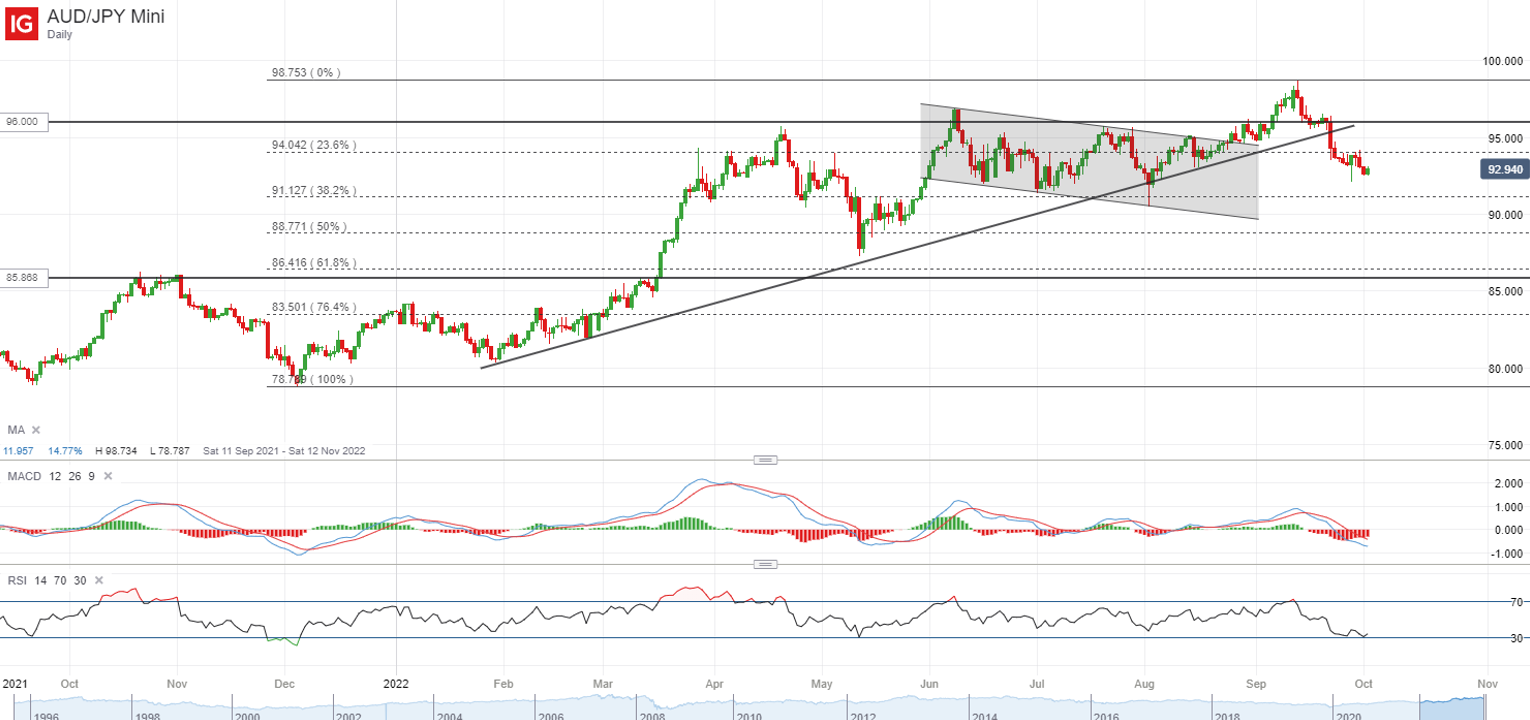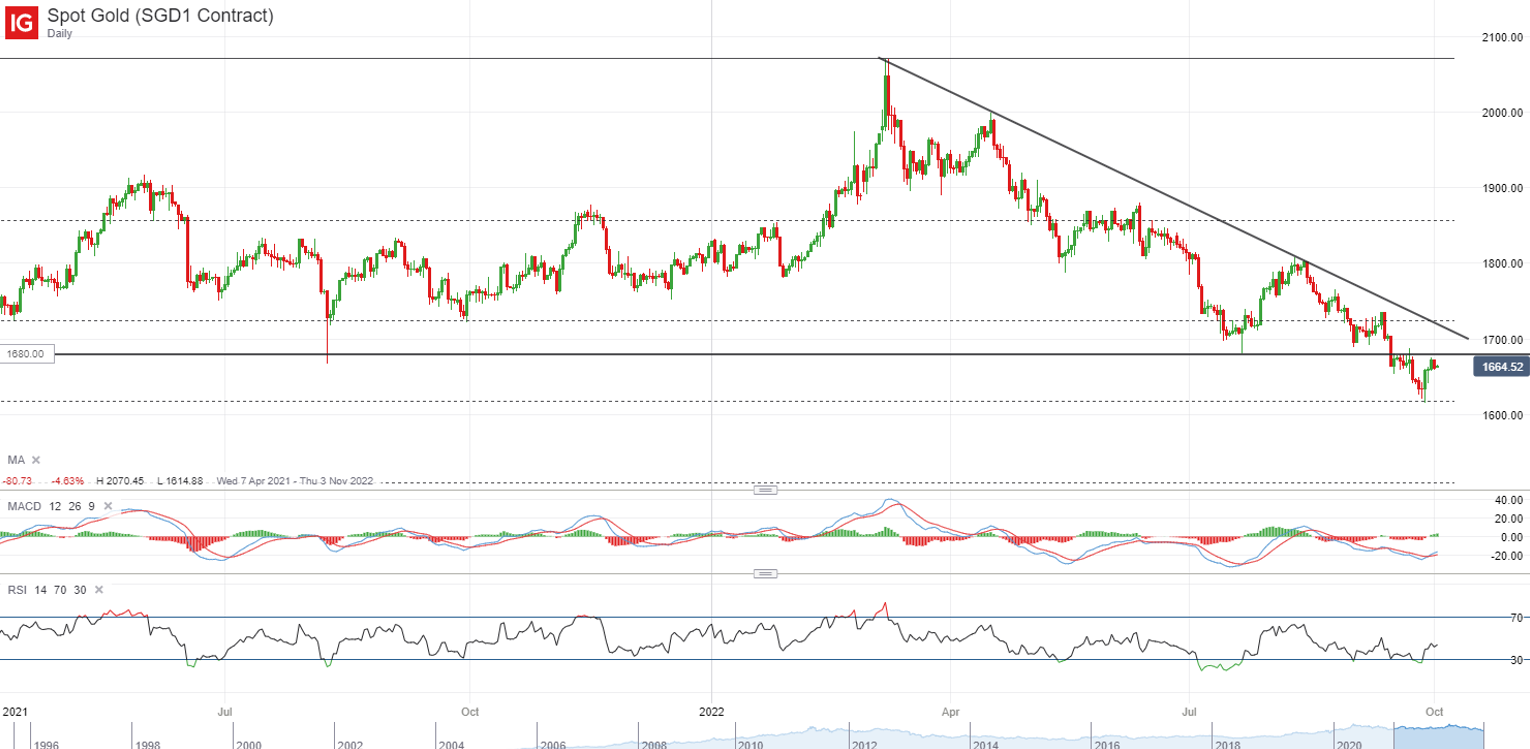Third consecutive quarterly decline for Wall Street: S&P 500, AUD/JPY, Gold
Major US indices officially closed out the month of September with a third consecutive quarterly decline, with the S&P 500 and Nasdaq delivering their longest losing streak since 2008.
 Source: Bloomberg
Source: Bloomberg
Market Recap
Major US indices officially closed out the month of September with a third consecutive quarterly decline, with the S&P 500 and Nasdaq delivering their longest losing streak since 2008. With both technical conditions and market breadth heavily flashing oversold levels, dip buyers were hoping for a near-term relief rally last week but that has not materialised thus far, as buyers failed to defend the closely-watched June bottom for the indices. The formation of a new lower low reinforces the overall downward trend but the preferred stance could be to wait for the formation of a lower high for the shorts, considering that the oversold technical levels could leave markets to an aggressive short-covering upmove in the event of a near-term relief catalyst. The relentless rise in US real yields remains on watch for any temporary pause, and although the US dollar has retraced slightly by 2.7% at the latter half of last week, that has not translated into what should have been a positive reaction thus far. The much-needed relief in risk assets will remain on watch this week.
The release of the US core Personal Consumption Expenditures (PCE) price index for August last Friday continued to present the upside risks to inflation with a more persistent reading of 4.9% (versus previous month 4.7%), although the headline PCE reading seems to support the peaking-inflation narrative with the third consecutive month of decline. Despite showing a similar trend to the August US Consumer Price Index (CPI) data, along with having heard a series of hawkish comments post-Fed, it seems that markets were not done pricing for the ongoing front-loading process of interest rate hikes last week. The week ahead will leave the non-farm payroll as the key risk event of the week, with another 250,000 job gains expected for September. A blowout reading (probably above the 300,000 range) could reinforce tighter Federal Reserve (Fed) policies and could be what market bulls are afraid to see.
For the S&P 500, the next support level to watch remains at the 3,500 level. This is where a 50% Fibonacci retracement level stands in place from its Covid-19 bottom, and could also mark the completion of a previous head-and-shoulder pattern. Resistance may be at the 3,800 level, where a confluence of Fibonacci levels resides.
 Source: IG charts
Source: IG charts
Asia Open
Asian stocks look set for a negative open, with Nikkei -1.17% and ASX -0.60% at the time of writing. There were no signs of relief in Wall Street to end last week, coupled with continued weakness in US equity futures this morning, which have contributed to a negative backdrop for Asian stocks. The South Korea market is closed for their National Day holiday, while China markets will be closed for the Golden Week holiday, suggesting a relatively lower-volume start to the new week. Economic data this morning continues to highlight the prevailing growth risks in the region, as Japan’s manufacturing sentiments unexpectedly worsen to its weakest level since March 2021. Elevated costs of commodities remain a key headwind for production sentiments, with the ongoing moderation in global economic activities and a weaker yen on its central bank’s policy divergence. A series of manufacturing Purchasing Managers' Index (PMI) figures across the region also showed lower-than-expected print in Taiwan, but pockets of strength were seen in Indonesia, Philippines and Thailand, which saw a stronger expansion from the previous month. Singapore’s September PMI will be released later today as well and with August reading of 50 treading at a fine line between expansionary and contractionary territory, the upcoming reading could be crucial.
The Australia’s Reserve Bank of Australia (RBA) interest rate decision will be announced tomorrow, with expectations split between a 25 basis-point (bp) and a 50 bp hike. After the AUD/JPY broke to a new high since 2015, the dented risk environment has driven some retracement, with a retest of the 94.126 level marked with a bearish rejection. A 25 bp increase tomorrow could potentially drive further weakness in the pair, leaving the 91.127 level on watch next where a key 38.2% Fibonacci support resides.
 Source: IG charts
Source: IG charts
On the watchlist: Gold prices heading to retest key support-turned resistance level at US$1,680
Despite an ongoing uptick in US real yields to end last week, gold prices have managed to shrug it off with an overall slight move higher, although the lower highs and lower lows continue to present an overall downward trend. The confluence of a weaker US dollar, along with some reversion from oversold technical levels, seems to be the catalyst of its resilience. For now, gold prices have managed to recover from the US$1,620 level, where a longer-term 50% Fibonacci level resides from its 2018 bottom. That said, the US$1,680 level will serve as a key support-turned-resistance level to overcome and having no slack in Fed’s interest rate outlook for now suggests that any upside could eventually be sold into, leaving the formation of a lower high on watch.
 Source: IG charts
Source: IG charts
Friday: DJIA -1.71%; S&P 500 -1.51%; Nasdaq -1.51%, DAX +1.16%, FTSE +0.18%




0 Comments
Recommended Comments
There are no comments to display.
Create an account or sign in to comment
You need to be a member in order to leave a comment
Create an account
Sign up for a new account in our community. It's easy!
Register a new accountSign in
Already have an account? Sign in here.
Sign In Now